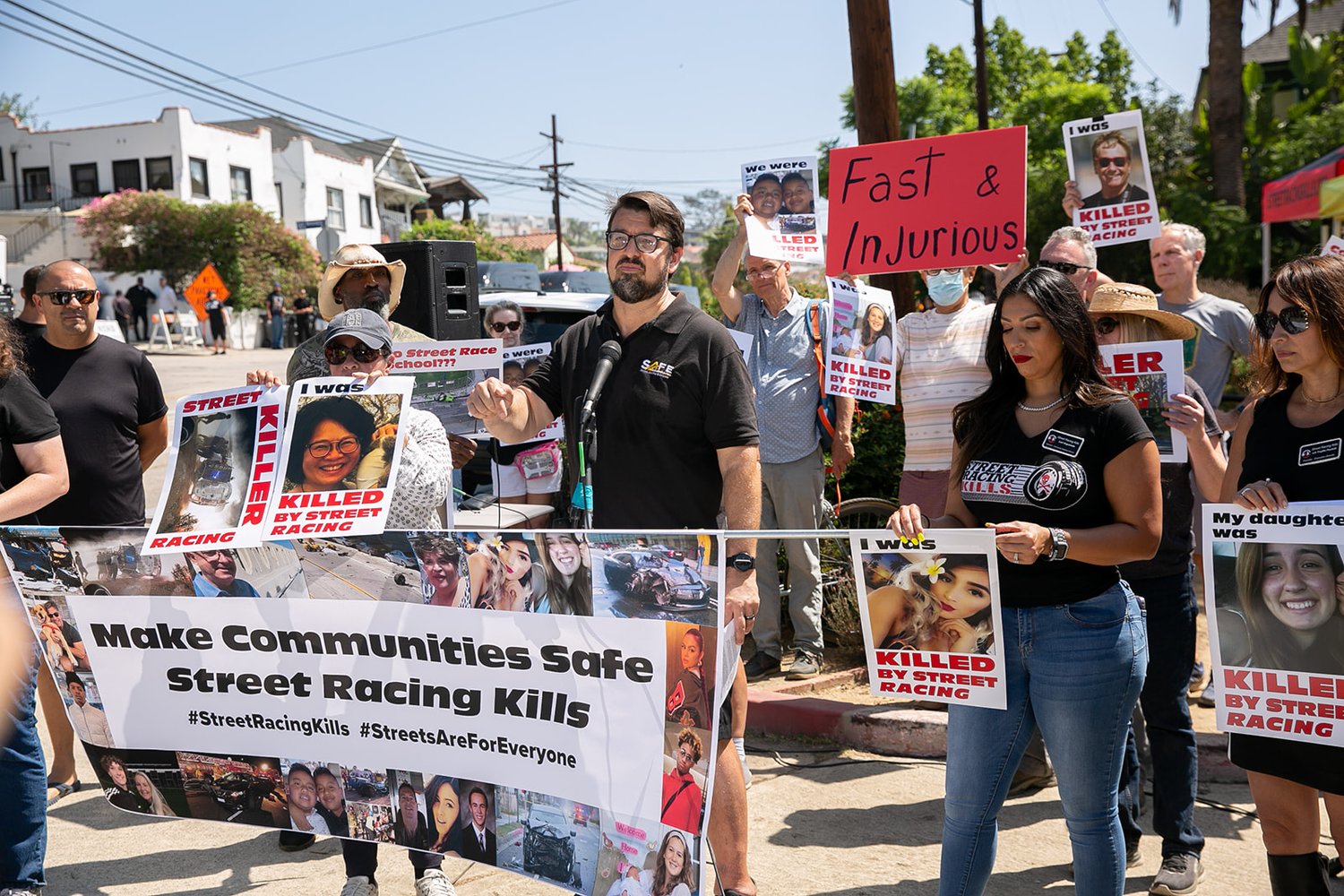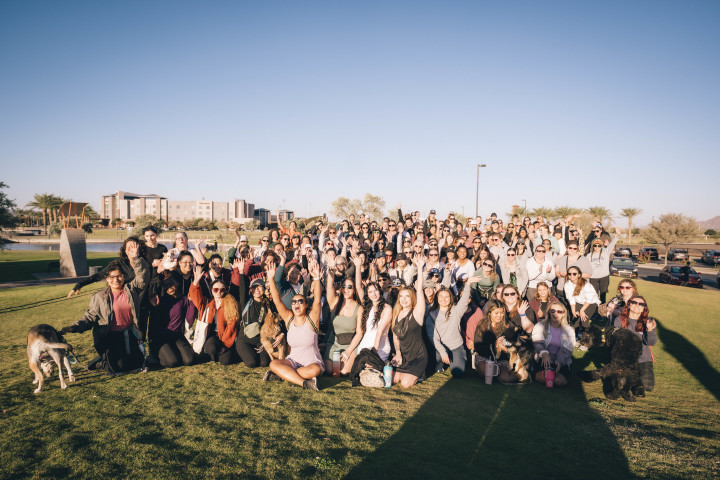‘It Was No Accident’: LA Traffic Violence Survivor Thinks Waymo Could Make City’s Streets Safer
Play VideoRead
Streets Are For Everyone
In Hollywood movies, Los Angeles streets are pleasant byways lined with palm trees where happy people stroll and sparkling convertibles cruise gently into dreams.
In real life, they are mostly roaring, multi-lane freeways where 5,000-pound hunks of metal hurdle toward other freeways, and the number of pedestrians killed in traffic crashes has outnumbered all other types of fatalities since 2010.
This is where, ten years ago, cyclist and Angeleno native Damian Kevitt nearly lost his life.
In February 2013, Damian was cycling along an overpass heading into Griffith Park when he was hit and pinned under a light-colored minivan. He was dragged nearly a quarter of a mile down the I-5 freeway; the driver didn't stop.
“I remember looking up at the underside of the car and realizing that I was on the freeway on-ramp,” Damian recalls. “I realized in those few seconds [the driver] wasn't stopping. He was speeding up. I could feel him speeding up. And it was a decision.”
The driver continued pressing the gas pedal, crushing Damian’s right leg, breaking 10 of his ribs, shattering his pelvis and wrist, and right shoulder -- and those were just the major injuries. In his fight to get out from under the vehicle, Damian nearly lost his left leg too, but he escaped.
Damian’s wife was the first one to find him on the freeway.
“Somehow or another, I survived,” Damian shares. “You could call it luck, you could call it karma, you could call it a miracle, a blessing, a second chance from God… whatever you want to call it, the truth is I shouldn't be here.”
Damian was rushed to LA County General Hospital where he underwent many surgeries over the next few months. His body may have been broken, but Damian’s spirit was resilient. Even on his second day in the hospital, Damian felt a conviction growing inside him. It was turning into a vision.
Damian spent four months in the hospital, undergoing nearly a dozen surgeries.
“After the doctors left, I turned to my wife and to my mom and I said, ‘When I get out of the hospital, I'm going to finish that ride that I started that day … and I'm going to run the 2015 LA Marathon.’”
Since that day in the hospital, Damian’s vision to finish his ride has not only happened, but grown into two major annual community events called Finish the Ride and Finish the Run, which draw cyclists, runners, and walkers to raise awareness about the need for safer streets and celebrate what the world could look like without traffic violence.
“When you deal with a traumatic situation, if you can figure out how to take that trauma and turn it into something good, you can use that action to heal,” says Damian.
Damian also created the LA nonprofit advocacy organization Streets Are for Everyone (SAFE), to make streets safer for pedestrians and cyclists, support the loved ones and victims of traffic crimes, and eliminate preventable traffic injuries and deaths.
SAFE merges strategies including education, broad awareness campaigns, partnerships, community outreach, and advocacy to drive its mission of making the roads safer for all. SAFE also provides support to victims of traffic violence and their loved ones.

SAFE aims to improve the quality of life for vulnerable road users by reducing traffic fatalities to zero.
Damian’s wife, Kylea-Rose Kevitt, works at SAFE too, doing graphic design, promotion, and managing the organization’s website, as well as running a traffic safety film competition for high schoolers who are learning to drive.
“Anytime we hear of a fatality or a family who's lost a loved one, we are like, ‘How can we help? What can we do? How can we reach them? Do we have someone in that neighborhood who can find them so that we can connect,’” shares Kylea-Rose. “Something that I find incredible about [Damian] is his drive and his passion and his life that he will take to any subject he touches.”
Damian points to his own experience as an example of the preventable nature of many pedestrian and cyclist injuries and fatalities. The driver who injured Damian made a decision to keep driving.
Instead of calling what happened an ‘accident,’ Damian uses a different term for the horror he experienced: traffic violence.
“Just by acknowledging the fact that these are not accidents, these are avoidable crashes or collisions that's when you start to move the needle,” Damian explains. “And then you can change things.”
Just by acknowledging the fact that these are not accidents, these are avoidable crashes or collisions that's when you start to move the needle. And then you can change things.
The National Highway Traffic Safety Administration (NHTSA) projects that the number of traffic fatalities in 2022 was 42,795.
“Traffic violence is out of control in the U.S,” Damian emphasizes. “The U.S. is considered a first-world country, but it is three to four times deadlier than England in terms of traffic safety.”
In 2022, Los Angeles had a record-breaking number of traffic fatalities, over half of them pedestrians and other vulnerable road users (VRUs) like cyclists and scooter riders. Damian says there is no single solution.
“Traffic violence is a multifaceted problem,” Damian emphasizes. “It's not just hit-and-runs. It's not just pedestrian safety. It's not just about cycling safety. It's not just distracted driving or drunk driving: it’s all of it.”
Traffic violence is a multifaceted problem. It's not just hit-and-runs. It's not just pedestrian safety. It's not just about cycling safety. It's not just distracted driving or drunk driving: it’s all of it.
Among other solutions, Damian and Kylea-Rose believe that autonomous driving technology like Waymo’s could one day help push down traffic fatalities. Waymo’s technology is designed to be a courteous driver, follow road rules, obey speed limits, and prioritize the safety of passengers and other road users like cyclists and pedestrians.

SAFE believes Waymo's autonomous driving technology can help reduce traffic fatalities.
When Damian and Kylea-Rose rode in a Waymo in Santa Monica, they looked at the windows and used a passenger screen to observe what the vehicle was seeing with its high-tech, 360-degree vision system as it followed the speed limit, even slowing down in a construction zone.
“It is amazing how the cyclist came past; it saw the cyclist… the whole little pack,” Kylea-Rose said.
Damian called his father excitedly from the vehicle. “Apparently, I've been replaced as Kylea's new favorite driver by Waymo. It's actually very smooth!”
Kylea-Rose says, even though she was a little nervous before her ride, Waymo is a great part of the puzzle of addressing traffic violence.
“I think autonomous driving is a great solution to human error,” Kylea-Rose emphasizes, adding that it could reduce drunk and distracted driving as well as speeding. “Watching it in action, how it handled emergency vehicles, how it handled a group of cyclists, pedestrians, and construction zones. It was fantastic.”
I think autonomous driving is a great solution to human error. Watching it in action, how it handled emergency vehicles, how it handled a group of cyclists, pedestrians, and construction zones. It was fantastic.
Damian and Kylea-Rose know there’s not a one-size-fits-all solution, but they know something has to change.
At a recent meeting for the families of victims of traffic violence, Damian provided support and comfort.

SAFE Support provides resources, support and help to traffic violence victims, family or friends.
Bell Enamorado shares how the man she thought of as a father was killed by a speeding driver going 100 miles per hour in a 40 mile-per-hour zone.
“It just hurt so much that all his hard work and everything that he accomplished was just taken in a matter of seconds because people wanted to have fun and street race and drive recklessly,” she says.
Darlene Smith shares how her beloved sister was a foster mother and loving wife before she was killed by traffic violence.
“It just really sucks that someone would just come and take someone's life like it didn't matter,” she says, beginning to cry. “All of us are sitting here because they mattered. They mattered. They mattered. We matter.”
Stories like this drive Damian and Kylea-Rose to keep fighting to save lives and change the status quo when it comes to traffic safety.
“As long as I have breath in this body, I will continue to be hopeful because I'm involved in working with volunteers and with the SAFE team to make things better and working with companies like Waymo and our partner organizations to continue to push that forward,” says Damian. “So, yeah, I'm hopeful because I'm alive.”
And although it doesn’t have a quiet street lined with palm trees, Damian says he sometimes thinks his own Los Angeles story could be a film.
“The entire journey is worth a movie,” Damian says. “Maybe one of these days.”



